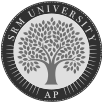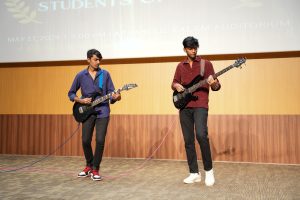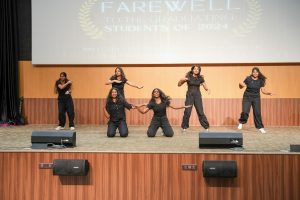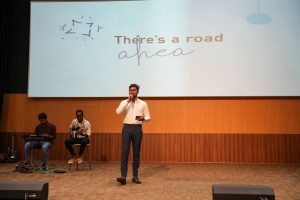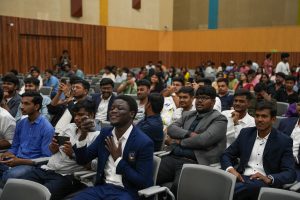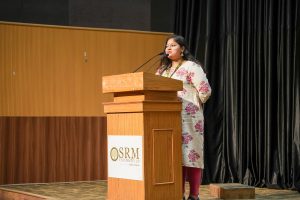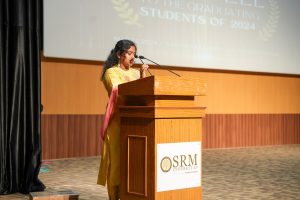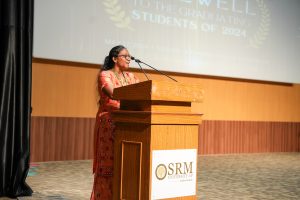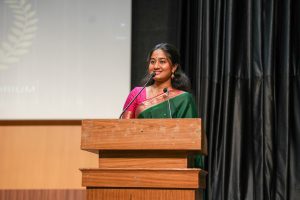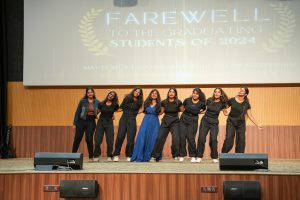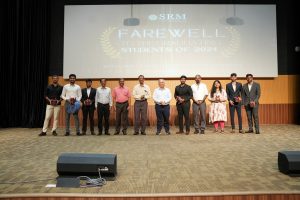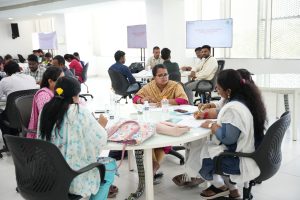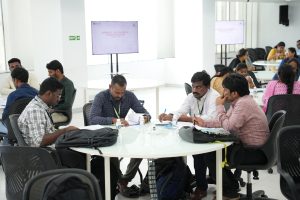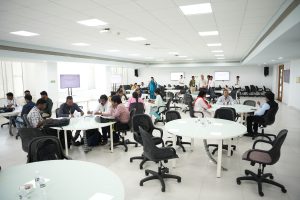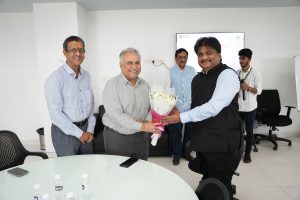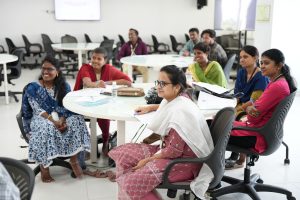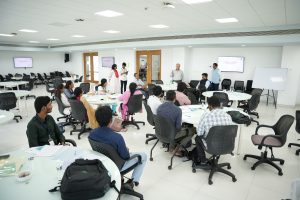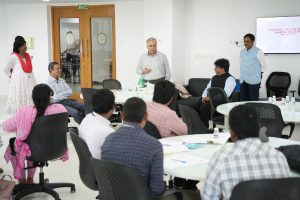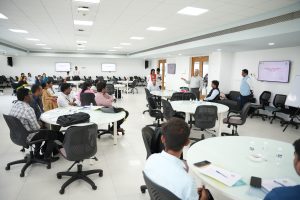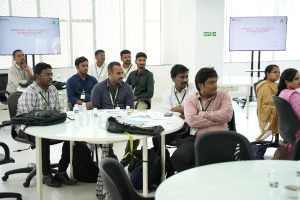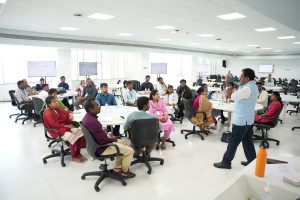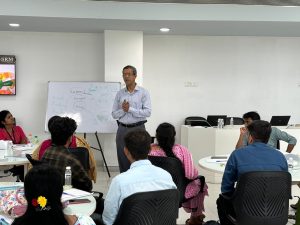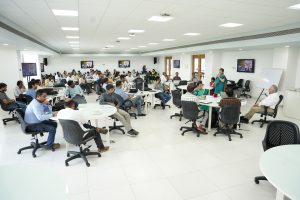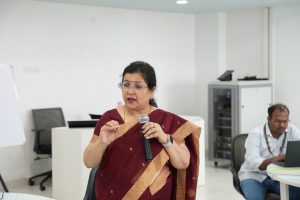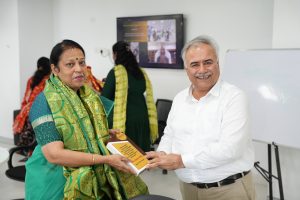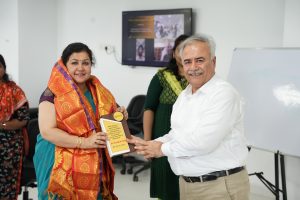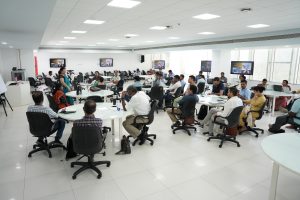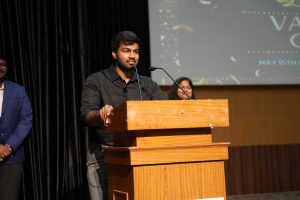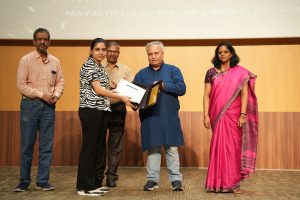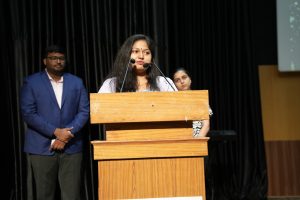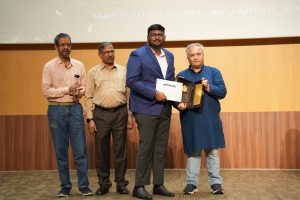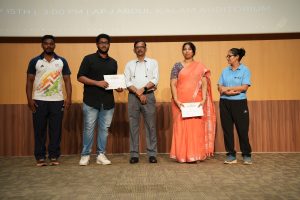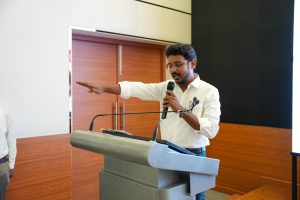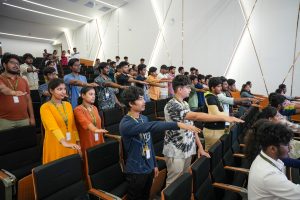SRM-AP All News
ALL News
- MOU Signed with IGCAR for Cutting-edge Biomedical Research May 28, 2024

“This is a remarkable opportunity for our students to enhance their fields of study, gain academic insights from expert scientists and participate in cutting-edge research projects at IGCAR. This will ensure that we at SRM AP nurture students with a great scientific temperament,” stated Prof. Manoj K Arora, Vice Chancellor of SRM University-AP on signing the MOU with IGCAR.
SRM University-AP has signed a Memorandum of Understanding (MOU) with the Indira Gandhi Centre for Atomic Research (IGCAR) at Kalpakkam, Tamil Nadu, to collaborate on academic and research projects in Biomedical Research, Disaster Management, and other domains. The MOU was signed by Dr B Venkatraman, Director-IGCAR and Prof. Manoj K Arora, Vice Chancellor, SRM University-AP in the presence of Dr Vidya Sundarrajan, Head PHRMD & QAD, IGCAR Kalpakkam, Mrs M Menaka, Head RAMS, RESD, SQRMG, IGCAR, Kalpakkam, Prof. Ranjit Thapa, Dean-Research, SRM AP and Dr K A Sunitha, Associate Professor, SRM AP.
The MoU underscores a mutually beneficial agreement between the two institutes. On the academic front, the MOU provides internship opportunities, research collaboration for projects and industry visits for the students and faculty of SRM AP. This ensures a knowledge transfer between the two organisations, promoting stellar growth in scientific and technological advancements.
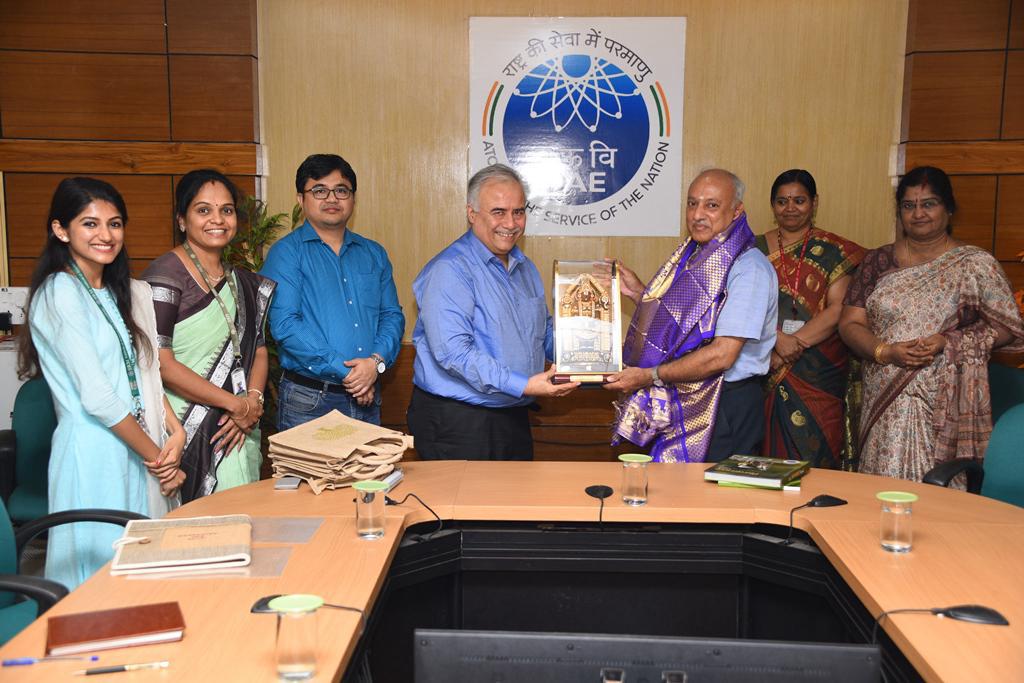
SRM AP has already collaborated with IGCAR on a consultancy project in the pioneering field of Biomedical Research last year. The parties have successfully conducted health screening of over 1500 subjects in the Chengalpattu region in Tamil Nadu, with SRM Medical Hospital & Research Centre and AIIMS Mangalagiri as secondary collaborators. Upon the successful completion of the project, IGCAR and SRM University-AP further extend their association with an official MOU for academic and research collaborations. “The MOU with SRM University-AP for translational research will be a huge motivation for the young faculty and scholars to pursue breakthrough research in their scientific domains,” remarked Dr B Venkatraman, Director-IGCAR.
Both institutes plan to extend their collaborative health screening project to the state of Andhra Pradesh, focusing on the neighbouring villages of SRM AP. Dr K A Sunitha, Project Head from SRM University-AP, opines that this project aims not just the possibility of translational research but also research for the societal cause. This research enables us to understand the correlated factors that influence various health disorders. Prof. Ranjit Thapa, Dean-Research also stated his enthusiasm for the project and expanding their research ventures to other domains.
Continue reading → - SRM University-AP Bids Farewell to the Graduating Batch of 2024 May 27, 2024
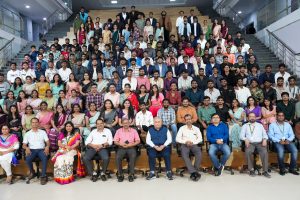 In a poignant and heartwarming event, The Directorate of Student Affairs at SRM University-AP bid adieu to its exceptional graduating batch of 2024. The farewell ceremony, held on the sprawling campus, was a celebration of achievements, camaraderie, and memories that will last a lifetime.
In a poignant and heartwarming event, The Directorate of Student Affairs at SRM University-AP bid adieu to its exceptional graduating batch of 2024. The farewell ceremony, held on the sprawling campus, was a celebration of achievements, camaraderie, and memories that will last a lifetime.The event celebrated the students’ academic journey and was marked by touching speeches delivered by deans and faculty members. The farewell ceremony was far more than a simple farewell. It transcended the mere act of bidding adieu to the graduating batch of 2024. Instead, it was a tapestry of emotions, a celebration of achievements, and a poignant moment that will linger in the hearts of all who were part of it. It incorporated various forms of artistic expression, including musical and dance performances by the juniors that added a vibrant and lively atmosphere to the occasion. Additionally, the ramp walk showcased the style and panache of the graduating students, highlighting their unique personalities.
Throughout the event, students were presented with accolades for their outstanding academic performance and exemplary leadership. As the sun set on the farewell ceremony, the Class of 2024 could be seen looking towards the future with hope and excitement. They carry with them not just degrees but also a legacy of excellence, resilience, and strong bonds of camaraderie forged during their time at SRM University-AP.
SRM University-AP expressed immense pride in its graduating students, who have demonstrated exceptional dedication and commitment to their education. The institution eagerly anticipates the future achievements of the Class of 2024.
Congratulations are in order for these bright minds as they embark on new adventures and endeavours. Here’s to a successful and fulfilling journey ahead for the Class of 2024!
Continue reading → - DEEPS Organised First Management Development Programme May 27, 2024
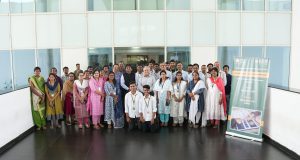 In a bid to empower working professionals and foster their continued growth, the Directorate of Executive Education and Professional Studies (DEEPS) at SRM University-AP organised a comprehensive 2-day Management Development Programme on “Selling Skills and Customer Relationship Management” in the presence of Vice Chancellor, SRM University-AP Prof. Manoj K Arora; Managing Director of Andhra Pradesh State Co-operative Bank, Dr R S Reddy; Dean-Academic Affairs, Dr Vinayak Kalluri; Dean-Paari School of Business & Director-DEEPS, Prof. Bharadhwaj Sivakumaran; and Assistant Director-DEEPS, Ms Sailaza Kosaraju. This programme was specially designed for the employees of the Andhra Pradesh State Co-operative Bank.
In a bid to empower working professionals and foster their continued growth, the Directorate of Executive Education and Professional Studies (DEEPS) at SRM University-AP organised a comprehensive 2-day Management Development Programme on “Selling Skills and Customer Relationship Management” in the presence of Vice Chancellor, SRM University-AP Prof. Manoj K Arora; Managing Director of Andhra Pradesh State Co-operative Bank, Dr R S Reddy; Dean-Academic Affairs, Dr Vinayak Kalluri; Dean-Paari School of Business & Director-DEEPS, Prof. Bharadhwaj Sivakumaran; and Assistant Director-DEEPS, Ms Sailaza Kosaraju. This programme was specially designed for the employees of the Andhra Pradesh State Co-operative Bank.The MDP played a crucial role in honing customer relationship management among working professionals, thereby enhancing their knowledge, skills, and leadership capabilities. The industry-oriented faculty members of SRM AP trained the participants to unlock the employees’ full potential, promote leadership, and drive organisational success.
During the inauguration, Vice Chancellor Prof. Manoj K Arora emphasised the broader impact of the programme, stating, “In these two transformative days, you will immerse yourselves in a wealth of knowledge and practical insights that will revolutionise your approach to customer relationship management. Our esteemed faculty members will guide you through the intricacies of selling skills, empowering you to build lasting connections with customers and drive organisational success.”
Dr R S Reddy, shared his enthusiasm, stating, “I am filled with unwavering confidence that our employees will acquire the desired skills through this MDP. SRM AP has consistently demonstrated its commitment to excellence, and we eagerly anticipate forging stronger connections with this prestigious institution. Together, we will not only elevate the capabilities of our employees but also foster enduring partnerships that will shape the future of our organisations.”
Prof. Bharadhwaj Sivakumaran added, “Our goal is to bridge the gap between theoretical knowledge and practical application. MDPs like these will provide participants invaluable insights into customer relationship management and selling skills, which are crucial for their day-to-day operations.”
SRM University-AP is committed to organising more MDPs in an array of areas, including Business Analytics, HR, Finance, Operations Management, and technical areas like Cyber Security, A/IML, and Robotics, among others. The primary motive behind such training and workshops is to facilitate overall professional development among the participants.The MDP will begin a transformational journey for the participating employees, which is expected to boost their career trajectory and contribute to the broader success of their organisation.
Continue reading → - NITTTR and SRM AP Collaborate for Trainer Programme on Outcome-Based Education May 27, 2024

SRM University-AP organised a “Train to Trainer Programme on Outcome-Based Education (OBE)” for the faculty of the varsity to ensure a comprehensive understanding and implementation of OBE principles across all academic programmes. The five-day programme, initiated on May 20, 2024, was conducted by trainers from the National Institute of Technical Teachers’ Training Research (NITTTR), Chandigarh. The programme was inaugurated in the presence of Prof. Bhola Ram Gurjar, Director of NITTTR (joined virtually), Prof. Maitreyee Dutta, Professor and Head of Information Management and Emerging Engineering Department, NITTTR, Dr Meenakshi Sood, Associate Professor CDC, NITTTR, Prof. Manoj K Arora, Vice Chancellor, SRM University-AP, Deans of all schools, Directors and Faculty members of the institute.
The programme comprised customised training sessions and modules that covered various aspects of OBE framework design such as Implementation, Challenges, Strategies, Best Practices, Case Studies, Student Testimonials, Impact Analysis, Future Scope, etc. Trainers from NITTTR – Prof. Rama Krishna, Prof. Maitreyee Dutta, Prof. Sandeep Singh Gill, Dr Meenakshi Sood, Dr Balwindar Singh, Er Amandeep Kaur delivered the sessions.
A total of 40+ faculty members were chosen to receive training from the NITTTR Team. These faculty will be the programme-wise coordinators and master trainers, who will then train the rest of the faculty in their respective programmes and departments. This systematic training ensured that every faculty member of the university had a comprehensive and in-depth understanding of OBE and its impact on the present education system.
Continue reading → - A New Chapter Begins: Welcoming the Vibrant Leaders of Student Council 2024-25! May 17, 2024
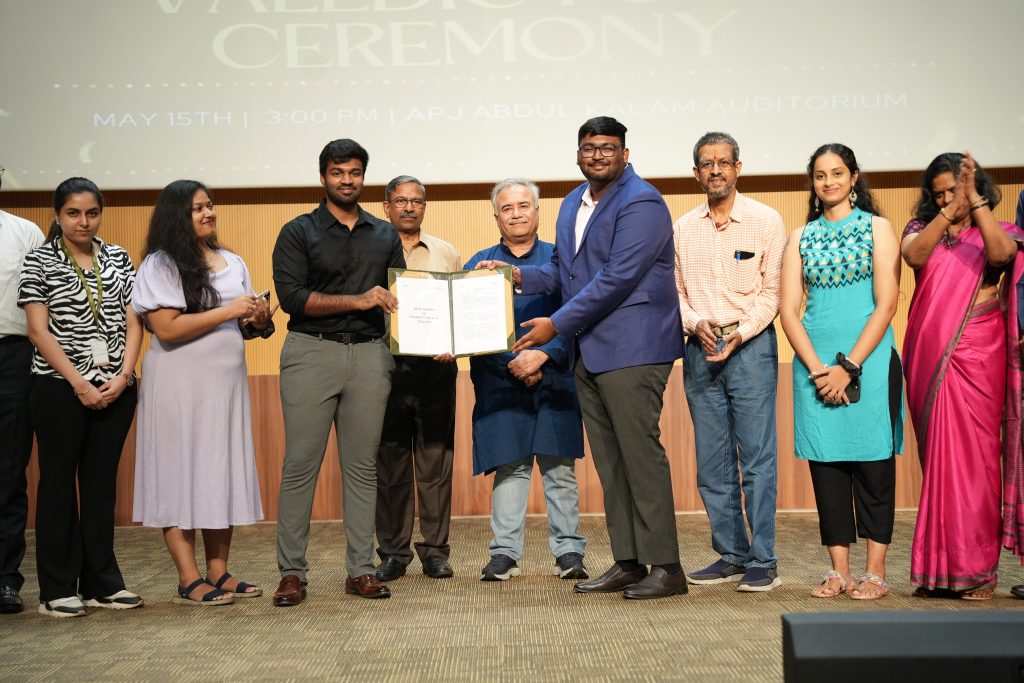
The Directorate of Student Affairs hosted a wonderful Valedictory Ceremony on May 15, 2024, marking a momentous occasion as the university bid farewell to the outgoing Student Council and welcomed the new core team.
The campus bid adieu to Preetam Vallabhaneni, Niruktha Vadlamudi, Sanjana Maini, and Laxman Bankupalle, the charismatic heads of the previous Student Council and applauded them for their phenomenal leadership. Their dedication to managing student needs, organising fests, and ensuring a vibrant campus life has set an incredible standard.
The baton has now been passed to a dynamic new team: Laxman Bankupalle, Nivedha Sriram, Ankith Reddy, and Rishabh Ranjan Ishwar, who will serve as the President, Vice President, General Secretary and Treasurer of Student Council 2024-25. The vibrant team is ready to take the reins and elevate the student experience even further. “With their remarkable capabilities, we are confident that they will continue to strengthen the bridge between the student community and university management”, stated Vice Chancellor Prof. Manoj Arora, as he welcomed the new student leaders. Associate Director-Student Affairs, Ms Revathi B exclaimed, “A new team brings in new energy, a new chapter”, as she perfectly captured the spirit of this transition.
The ceremony also recognised the outstanding contributions of all clubs, societies and committee members, SC members, NSS, CESR (Corporate Engagement and Social Responsibilities), sports teams, and volunteers. The event was graced by the presence of our esteemed Registrar, Dr R Premkumar, CFAO Ms Suma Nulu, Deans, Directors, Faculty and Students of the varsity.
Continue reading → - Innovative Wind Turbine System Patent Awarded to Dr Goutam Rana and Team May 16, 2024
 In a significant advancement for sustainable energy technology, the Indian Patent Office Journal has officially granted a patent for the “Mini magnetically levitated wind turbine system for power generation.” This groundbreaking invention, bearing Application Number: 202241051560, is the brainchild of Dr Goutam Rana, Assistant Professor in the Department of Electronics and Communication Engineering.
In a significant advancement for sustainable energy technology, the Indian Patent Office Journal has officially granted a patent for the “Mini magnetically levitated wind turbine system for power generation.” This groundbreaking invention, bearing Application Number: 202241051560, is the brainchild of Dr Goutam Rana, Assistant Professor in the Department of Electronics and Communication Engineering.Dr Rana, along with his dedicated team of B. Tech ECE students—Mr Vybagula Sai Vamsi, Mr Moparthi Teja, Mr Indrakanty Satwik, and Mr Pidikiti Venkata Abhinash have developed a system that promises to revolutionise how we harness wind energy. The turbine’s miniaturised and magnetically levitated design allows for efficient power generation with minimal mechanical friction, leading to a longer lifespan and reduced maintenance costs.
The team’s innovation aligns with global efforts to transition to renewable energy sources and showcases the potential of academic research in contributing to real-world challenges. The patent grant not only recognises the technical ingenuity of the invention but also underscores the collaborative spirit of the students and faculty at the institution.Abstract:
Due to the increasing demand and supply gap, in the electrical energy system, wind energy is coming out as an alternative form of clean-with zero-carbon footprint renewable energy sources for power generation. The same is true for hydrocarbon-based fuels whose resources are limited and the contribution of vehicular pollution is also raising concerns in every-degrading the air quality index (AQI) of Indian cities. The electric and hybrid vehicles thus emerging fast as an alternative but often being hindered by the unavailability of proper charging infrastructures on roads.
The current invention is aimed to enable the use of wind turbines for harnessing wind energy and utilize the same to charge batteries of electrical vehicles or hybrid vehicles. The major challenges that have prevented the use so far are mainly two viz. low air flow and larger air drag. To address low airflow in normal road conditions in congested city alleys, we demonstrated the use of magnetically levitated Vertical-axis turbines instead of conventional ball-baring-based Horizontal-axis wind turbines. To reduce the air drag the use of vertical axis magnetically levitated wind turbines is a good option since the air drag experienced in the blade unit is not exactly in contact with the car body.
To improve on the drag further we have introduced an array of mini turbine units instead of one big unit which helps in distributing the total drag over a large area and since air can pass easily through small units overall drag experienced will be small. Also, to keep the levitation small, the rotating unit is made lighter with 3D printing perforated PLA material.
The rest of the operation of the system is similar to any wind turbine system i.e. with the help of permanent magnet and coil arrangement we will convert the wind energy (rotor movement) into electrical energy (e.m.f.). Only here instead of one single source, we will generate multiple small sources of induced electrical energy which can then be coupled together and used for charging the battery.Since the invention uses magnetic levitation, friction is minimal. This helps the rotor to become independent of natural wind flow and use the movement of the vehicle to generate the required torque for the rotor movement. Our invention can be installed in the rooftop space of any vehicle and since it is divided into an array of smaller units, allows the optimum use of available space of the used vehicle. Overall cost and weight are also very minimal. Here, the most practical use case can be the widespread E-rickshaws in India. The choice of the use case is based on the fact of their large presence, longer run hours, and limited speed for the runs.
Explanation of the Invention in Layperson’s Terms:
The invention will act as a source of energy and can be used to charge batteries of electric vehicles or hybrid vehicles. The device converts wind energy to electrical energy through mini wind turbine arrays which can be placed on top of the rooftop of the vehicles. The rotor is kept suspended from the stator unit using magnets to eliminate friction. This helps to operate the device without the presence of strong natural wind, it utilizes the movement of the vehicle to generate the necessary rotation. The mini turbine arrays and magnetic suspension help to reduce the effect of wind drag (extra wind replaced by the turbine unit).Practical Implementation or the Social Implications Associated
The invention is intended to solve a few on-road challenges of Electric Vehicles (EVs). The current invention is:
1. Low cost and one-time investment with zero maintenance charge for an EV
2. The proposed device can act as a secondary power source for the vehicle
3. The proposed device will convert wind energy, thus completely environment-friendly, and with comes with absolutely zero carbon footprint
4. The proposed device can add some extra mileage to the current battery storage as much as it runs.
5. With other renewable sources together a hybrid vehicle can be built which is free of fossil fuel completely.Future Research Plans:
The current invention is in just proof of concept stage. We are currently working on the following
Continue reading →
1. to improve the overall efficacy of the device such that each unit can harness wind energy to its optimal potential. With this, we will try to ensure that the battery gets charged completely (or at least a significant percentage) during each run during the day.
2. We are also working on the numerical study to calculate the actual wind drag with a more optimal design so that we can estimate how many units a certain vehicle will require and what should be the optimal placement scheme to utilize the maximum wind effect. - Groundbreaking Research on Optimal Routing Protocol in IEEE Sensors Journal May 15, 2024
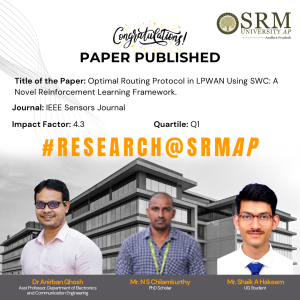 In a significant academic achievement, Dr Anirban Ghosh, Assistant Professor from the Department of Electronics and Communication Engineering along with Mr Naga Srinivasarao Chilamkurthy, PhD Scholar, and Mr Shaik Abdul Hakeem, an undergraduate student, have made a remarkable contribution to the field of communication engineering. Their paper, titled “Optimal Routing Protocol in LPWAN Using SWC: A Novel Reinforcement Learning Framework,” has been published in the esteemed IEEE Sensors Journal, with an impressive impact factor of 4.3.
In a significant academic achievement, Dr Anirban Ghosh, Assistant Professor from the Department of Electronics and Communication Engineering along with Mr Naga Srinivasarao Chilamkurthy, PhD Scholar, and Mr Shaik Abdul Hakeem, an undergraduate student, have made a remarkable contribution to the field of communication engineering. Their paper, titled “Optimal Routing Protocol in LPWAN Using SWC: A Novel Reinforcement Learning Framework,” has been published in the esteemed IEEE Sensors Journal, with an impressive impact factor of 4.3.This publication marks a milestone for the university and highlights the innovative research being conducted by its faculty and students. The paper delves into the development of an optimal routing protocol for Low-Power Wide-Area Network (LPWAN) using State-Wise Communication (SWC), employing a novel reinforcement learning framework to enhance network efficiency and performance.
This work will pave the way for advancements in LPWAN technologies, which are crucial for the Internet of Things (IoT) ecosystem. The university community celebrates this achievement and looks forward to the positive impact it will have on technology and society.Abstract:
Low Power Wide Area Network (LPWAN) has emerged as a dominating communication technology that offers low-power and wide coverage for the Internet of Things (IoT) applications. However, the direct data transmission approach has a limited network lifetime. Even multi-hop data transmission experiences several difficulties including high data latency, poor bandwidth utilization, and reduced data throughput. To overcome these challenges, in this paper, a recent breakthrough in social networks known as Small-World Characteristics (SWC) is incorporated into LPWANs.In particular, in this work, Small-World LPWANs (SW-LPWANs) are developed by using the Reinforcement Learning (RL) technique and using different node centrality measures like degree, betweenness, and closeness centrality. Further, the performance of the developed SW-LPWANs is evaluated in terms of energy efficiency (alive/dead devices, and network residual energy) and Quality-of-Service (average data latency, data throughput, and bandwidth utilization), and is compared with that of conventional multi-hop LPWAN. Finally, to validate the simulation results, similar analyses are performed on the real-field LPWAN testbed.
The obtained simulation results confirm that SW-LPWAN developed by the RL method performs better than other techniques, with 11% more alive devices, 5.5% higher residual energy, 2.4% improved data throughput, and 14% efficient bandwidth utilization compared to the next best method. A similar trend is observed with real-field LPWAN testbed data also.
Explanation of the Research in Layperson’s Terms
Social networks primarily revolve around establishing human connections, whereas LPWANs are designed for connecting IoT devices that have limited battery-driven power. In this context, the smart devices must communicate in an IoT setting to conserve the limited energy available to them. To achieve this, the concept at the core of social networking also known as small world characteristic is incorporated into LPWAN using the Q-learning technique.
Practical Implementation or the Social Implications of the Research
IoT applications such as remote healthcare, smart environmental monitoring, asset tracking, and smart traffic systems require low transmission delay and high network lifetime. The proposed research helps in achieving the above parameters.

Collaborations
Dr Om Jee Pandey, Assistant professor Department of Electronics Engineering, Indian Institute of Technology, (BHU), Varanasi. e-mail: omjee.ece@iitbhu.ac.inDr Linga Reddy Cenkeramaddi, Professor, Department of Information and Communication Technology, University of Agder, Norway. e-mail:linga.cenkeramaddi@uia.no
Future Research Plan
Continue reading →
In the next phase of research, we will be interested in investigating how the energy efficiency and other quality of service of smart devices in an IoT setting can be improved if they are partially or completely mobile. - An Inventive Navigation System for the Visually Impaired May 15, 2024
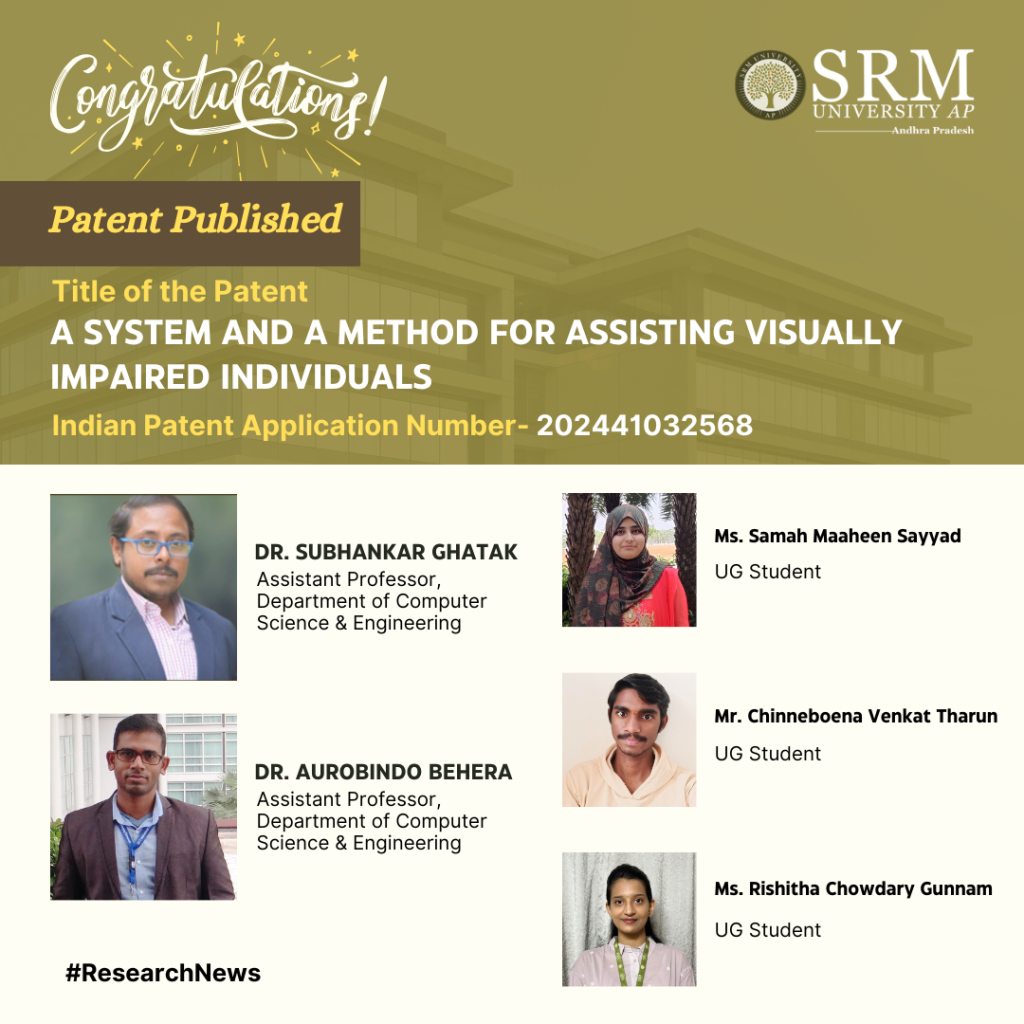
The Department of Computer Science and Engineering is proud to announce that the patent titled “A System and a Method for Assisting Visually Impaired Individuals” has been published by Dr Subhankar Ghatak and Dr Aurobindo Behera, Asst Professors, along with UG students, Mr Samah Maaheen Sayyad, Mr Chinneboena Venkat Tharun, and Ms Rishitha Chowdary Gunnam. Their patent introduces a smart solution to help visually impaired people navigate busy streets more safely. The research team uses cloud technology to turn this visual information into helpful vocal instructions that the users can hear through their mobile phones. These instructions describe things like traffic signals, crosswalks, and obstacles, making it easier for them to move around independently, making way for an inclusive society.
Abstract
This patent proposes a novel solution to ease navigation for visually impaired individuals. It integrates cloud technology, computer vision algorithms, and Deep Learning Algorithms to convert real-time visual data into vocal cues delivered through a mobile app. The system employs wearable cameras to capture visual information, processes it on the cloud, and delivers relevant auditory prompts to aid navigation, enhancing spatial awareness and safety for visually impaired users.
Practical implementation/Social implications of the research
The practical implementation of the research involves several key components.
- Developing or optimising wearable camera devices that are comfortable and subtle for visually impaired individuals. These cameras should be capable of capturing high-quality real-time visual data.
- A robust cloud infrastructure is required to process this data quickly and efficiently using advanced computer vision algorithms and deep learning algorithms.
- Design and develop a user-friendly mobile application that delivers processed visual information as vocal cues in real-time. This application should be intuitive, customisable, and accessible to visually impaired users.
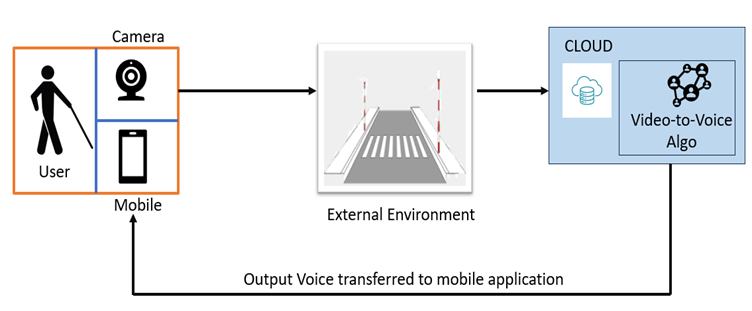
Fig.1: Schematic representation of the proposal
The social implications of implementing this research are significant. We can greatly enhance their independence and quality of life by providing visually impaired individuals with a reliable and efficient navigation aid. Navigating city environments can be challenging and hazardous for the visually impaired, leading to increased dependency and reduced mobility. The research aims to mitigate these challenges by empowering users to navigate confidently and autonomously. This fosters a more inclusive society where individuals with visual impairments can participate actively in urban mobility, employment, and social activities.
In the future, the research cohort plans to further enhance and refine technology to better serve the needs of visually impaired individuals. This includes improving the accuracy and reliability of object recognition and scene understanding algorithms to provide more detailed and contextually relevant vocal cues. Additionally, they aim to explore novel sensor technologies and integration methods to expand the capabilities of our system, such as incorporating haptic feedback for enhanced spatial awareness. Furthermore, we intend to conduct extensive user testing and feedback sessions to iteratively improve the usability and effectiveness of our solution. This user-centric approach will ensure that our technology meets the diverse needs and preferences of visually impaired users in various real-world scenarios.
Moreover, the team is committed to collaborating with stakeholders, including advocacy groups, healthcare professionals, and technology companies, to promote the adoption and dissemination of this technology on a larger scale. By fostering partnerships and engaging with the community, they can maximise the positive impact of their research on the lives of visually impaired individuals worldwide.
Continue reading → - Unlocking Cholesterol Homeostasis: A Mathematical Modelling Perspective May 14, 2024
 In a significant stride towards understanding cholesterol homeostasis, Dr Koyel Chakravarty, Assistant Professor and Mr Sukdeb Manna, a PhD Scholar in the Department of Mathematics has co-authored a paper titled “Unlocking Cholesterol Homeostasis: A Mathematical Modelling Perspective.” The paper has been published in the esteemed journal, The European Physical Journal Plus, with an impact factor of 3.4. This collaborative effort showcases the innovative application of mathematical modelling in unravelling the complexities of cholesterol regulation within the body.
In a significant stride towards understanding cholesterol homeostasis, Dr Koyel Chakravarty, Assistant Professor and Mr Sukdeb Manna, a PhD Scholar in the Department of Mathematics has co-authored a paper titled “Unlocking Cholesterol Homeostasis: A Mathematical Modelling Perspective.” The paper has been published in the esteemed journal, The European Physical Journal Plus, with an impact factor of 3.4. This collaborative effort showcases the innovative application of mathematical modelling in unravelling the complexities of cholesterol regulation within the body.The research not only contributes to the existing body of knowledge in this field but also sheds light on potential avenues for further exploration and understanding. Dr Chakravarty and Mr. Manna’s work underscores the importance of interdisciplinary approaches in scientific research and highlights SRM University-AP’s commitment to fostering cutting-edge research and innovation.
Their collaborative efforts serve as an inspiration to aspiring researchers and underscore the university’s dedication to pushing the boundaries of knowledge and discovery. Congratulations to Dr Chakravarty and Mr Manna on this remarkable achievement, and we look forward to more groundbreaking contributions from them in the future.
Abstract:
Limited progress in the mathematical modelling of cholesterol transport systems is hampering novel therapeutic interventions. This issue is addressed by the present study through precise design, employing four compartmental models to elucidate cholesterol dynamics in the comprehensive bloodstream. Disparities in medical advancements, particularly in cholesterol-related pathophysiology, are aimed to be bridged, advancing medical science and patient care outcomes.Therapeutic strategies for reducing blood cholesterol are explored by the model, with parameter influences on equilibrium stability revealed through sensitivity analysis. System parameters are effectively manipulated by imposing sensitivity analysis, and pinpointing areas for model refinement. Stability analysis contributes to diverse realistic models, confirming local asymptotic stability. Model efficacy in studying cholesterol transport dynamics is supported by analytical and numerical assessments. The study concludes with the present model validation to substantiate it by comparing the present outcomes with the existing ones.
Explanation of The Research in Layperson’s Terms:
Basically, scientists are having trouble figuring out how to model how cholesterol moves around in the body, which is important for developing new treatments. This study tries to solve that problem by creating detailed models that show how cholesterol behaves in different parts of the bloodstream. The goal is to bridge the gap in medical knowledge about cholesterol-related problems and improve how we treat patients. The models help us understand how different treatments might affect cholesterol levels, and by analyzing them closely, we can figure out which factors are most important. This lets us tweak the models to make them more accurate. The study shows that the models are reliable by testing them both analytically and numerically, and comparing the results to what we already know.
Practical Implementation or the Social Implications of the Research
1. Personalized Medicine: The mathematical models developed in this research could help in designing personalized treatment plans for individuals with high cholesterol levels. By understanding how different factors affect cholesterol dynamics, doctors can tailor therapies to each patient’s specific needs, leading to more effective and targeted treatments.
2. Drug Development: Pharmaceutical companies could use these models to screen potential drugs for lowering cholesterol. By simulating how different compounds interact with cholesterol transport systems, researchers can identify promising candidates for further testing, potentially speeding up the drug development process.
3. Healthcare Cost Reduction: Better understanding of cholesterol dynamics could lead to more efficient use of healthcare resources. By optimizing treatment strategies and preventing complications related to high cholesterol, healthcare costs associated with conditions like heart disease could be reduced, benefiting both individuals and society.
4. Public Health Initiatives: Insights from the research could inform public health initiatives aimed at reducing cholesterol-related diseases. For example, policymakers could use the models to design targeted interventions such as education campaigns promoting healthy lifestyle choices or policies to improve access to cholesterol-lowering medications.
5. Improved Patient Outcomes: Ultimately, the goal of this research is to improve patient outcomes by better understanding and managing cholesterol homeostasis. By developing more accurate models of cholesterol transport dynamics, healthcare providers can make more informed decisions, leading to better control of cholesterol levels and reduced risk of cardiovascular disease and other related conditions.Future Research Plans:
1. Current models may focus on a limited set of factors influencing cholesterol transport. Future research could explore the integration of additional biological factors such as genetic variations, hormonal influences, and dietary components into the models to create a more comprehensive understanding of cholesterol homeostasis.
2. Most existing models of cholesterol transport assume static conditions. Future research could develop dynamic models that capture the time-dependent changes in cholesterol levels in response to various stimuli, such as meals, physical activity, and medication intake. Dynamic models would provide a more accurate representation of real-world cholesterol dynamics and enable the evaluation of time-sensitive interventions.Picture Related to the Research
Continue reading →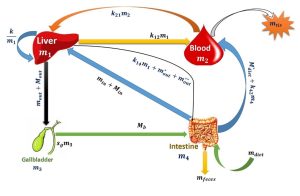
- #NoExcusesDay: Promoting Voter Awareness and Responsibility May 9, 2024
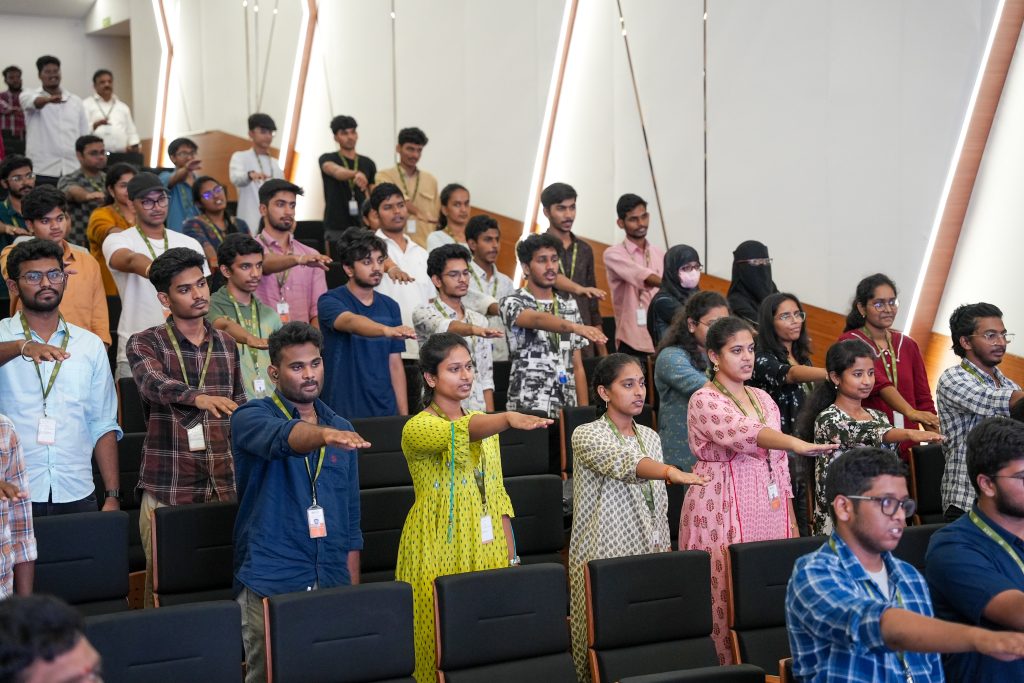
On the auspicious occasion of advocating for voter awareness and responsibility, a “#NoExcusesDay” event was held at SRM University-AP on May 09, 2024, organised by the Times of India and the Directorate of Communications of the university. The event, graced by Chief Guest, Mr Harendhira Prasad, Additional Chief Electoral Officer, aimed to emphasise the significance of voting in a democracy and to motivate citizens, especially the youth, to exercise their right to vote without fail.
The event commenced with the display of a motivating video message from President Draupadi Murmu, setting the tone for the importance of active participation in the electoral process. Highlighting the statistics of voting percentages in assembly elections from Hyderabad, the video presentation was followed by an address by Mr Rajiv Kumar, the Chief Election Commissioner, who underscored the importance of adding 97 crore voters to the electoral rolls.
The introduction of technology in the electoral process was a key point of discussion, with emphasis placed on the utilisation of advanced methods to ensure smooth and efficient polling. The staggering number of 10.5 lakh polling stations across the nation further underscored the magnitude of the electoral process.
Under the theme “Chunav Ka Parv Desh Ka Garv” (Festival of Elections, Pride of the Nation), the event witnessed active participation from students and faculty members alike. Mr Pankaj Belwariar, Director of Communications, and Mr Anil Nigam, Director of Student Affairs, graced the stage to extend their support and encouragement towards fostering a culture of voting. The event also provided a platform for students to share their first-time voting experiences. M. Kartika, Y. Ramya, V. Suma, and Tamineni Harnan Reddy shared their personal anecdotes, underscoring the sense of responsibility and empowerment that comes with casting a vote.
Mr Pankaj Belwariar’s impassioned speech resonated with the audience as he articulated the significance of treating voting as a non-negotiable duty. His “no-excuse day” message struck a chord, urging individuals to overcome obstacles and prioritise their democratic duty. Mr Anil Nigam elaborated on the disparities between rural and urban voting patterns, highlighting the heightened enthusiasm observed in rural areas. Aditya Challa, a fourth-year student, emphasised the symbiotic relationship between voting and the right to question, asserting, “No vote, no right to question.”

The event reached its pinnacle with the chief guest, Mr Harendhira Prasad’s speech, where the imperative nature of May 13th, termed as “D-day” for both assembly and Lok Sabha elections, was underscored. Stressing the importance of carrying approved identification cards for casting votes, the chief guest reiterated that voting is not just a right but a solemn duty that every citizen must fulfil.
The significance of the None of the Above (NOTA) option was elucidated, serving as a powerful tool for citizens to express dissent and demand accountability from political parties. The chief guest, Mr Harendhira Prasad, made a humble request for citizens to fulfil their duty with the same diligence as those involved in organising the elections, resonating deeply with the audience.
In conclusion, the event served as a poignant reminder of the privileges and responsibilities inherent in a democratic society. Through informative sessions, personal anecdotes, and impassioned speeches, attendees were galvanised to embrace their role in shaping the future of the nation through the simple yet profound act of voting. As May 13, 2024 approaches, the call to action reverberates loud and clear: no excuses, only votes.
Continue reading →

